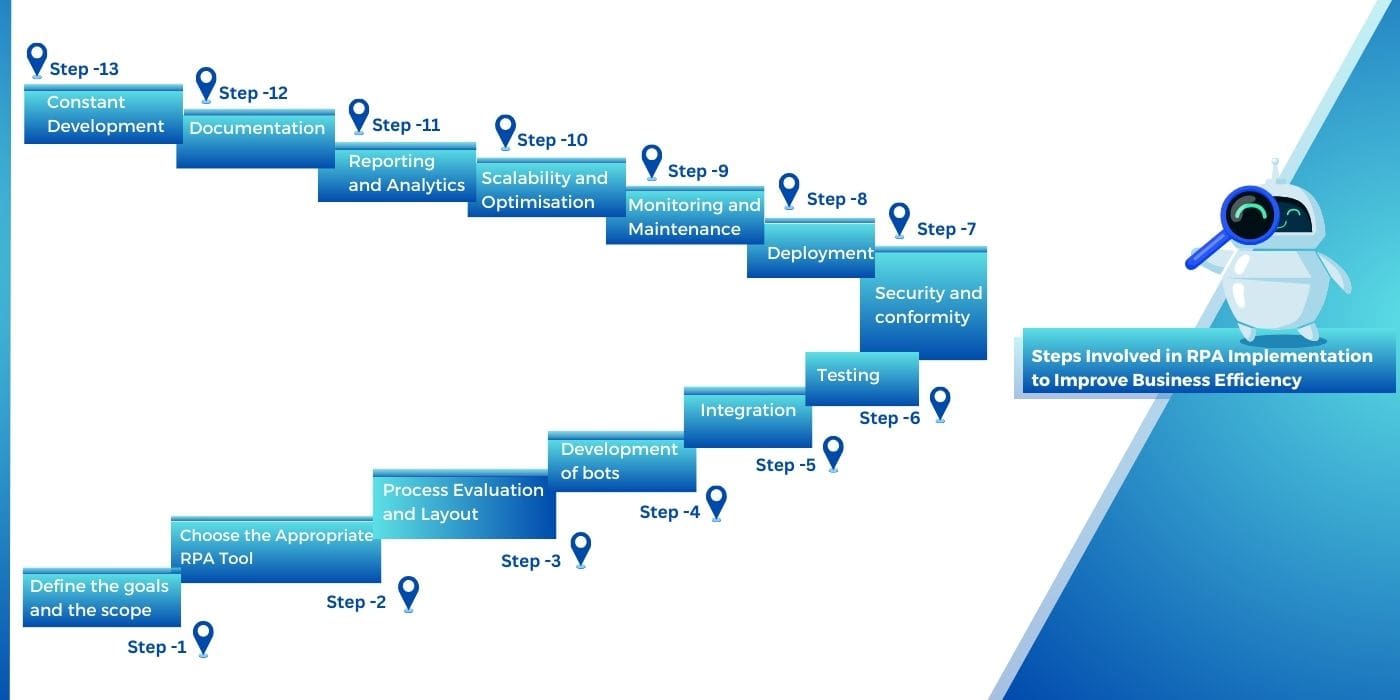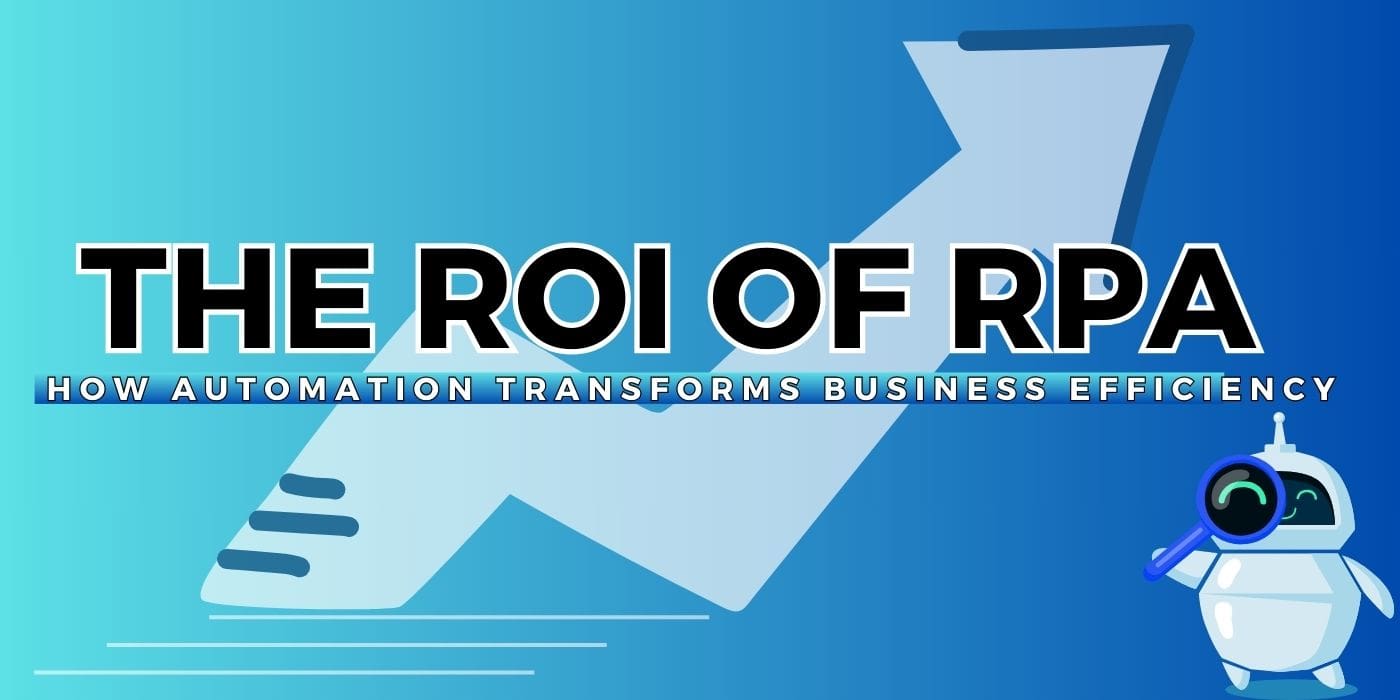To address the downsides and improve business efficiency, many
organizations invest in automation and digitization of their
processes.
Automation
can help reduce errors, increase speed, enhance scalability, and
provide better data security, ultimately leading to improved
overall business productivity.
Typically, manual tasks take longer than automated ones.
Projects or procedures may be behind schedule as a result of
employees taking longer to perform tasks. This inefficiency may
reduce production and degrade a company's overall performance.
Manual data gathering and analysis may not always yield
insightful information about how businesses operate. Better data
analytics capabilities are frequently provided by automated
systems, assisting organizations in making wise selections and
improving their business’s process efficiency.
How can RPA Improve Business Efficiency?
RPA can improve business process efficiency in a number of ways,
including:

Less Human Error
In manual data entry and repeated jobs, human error is
common. RPA bot’s complete jobs with high accuracy,
which lowers the possibility of mistakes. This may
result in fewer expensive errors and better data
quality.

Increased Speed
RPA can finish jobs considerably more quickly than
humans can, often working nonstop. This decreases the
amount of time needed to complete complex processes
efficiently, resulting in swifter customer turnaround
times and increased production.

Cost Savings
Businesses can cut labor expenses by automating business
processes that were previously completed by employees.
Although there are upfront costs associated with
adoption, there may be significant savings over time.

Greater Scalability
To adapt to changes in workload, RPA bot’s may be
quickly scaled up or down. This scalability enables
businesses to adjust to shifting demands without having
to hire or fire staff.

Enhanced Compliance
RPA can ensure that processes are consistently executed
according to compliance and regulatory requirements.
This reduces the risk of fines and penalties for
non-compliance.

Enhanced Customer Experience
Customer satisfaction can be increased by reducing
inefficiencies and responding more quickly to customer
requests. Order processing, invoice creation, and
customer support questions are among the processes that
RPA can automate for a business.

Flexibility
By automating data transfer and synchronization between
them, RPA helps close the gap between legacy systems and
contemporary software applications. This allows for
smooth data flow and improved decision-making for the
organization.

Workforce Augmentation
RPA enhances rather than completely replaces human
workers' abilities. RPA may handle manual-repetitive
processes so that employees can concentrate on more
important and valuable duties.

Analytics and Reporting
RPA may gather and analyze data from a variety of
sources to produce real-time reports and analytics.
Businesses gain insights from this to help them make
better decisions and improve their process efficiency.

Consistency
RPA bots execute tasks consistently, minimizing process
execution variances. This could raise the general
caliber of goods and services.

Quick ROI
Due to the cost reductions and efficiency advantages
realized, RPA systems can offer a reasonably quick
return on investment (ROI) for a business.
Improve Your Business Efficiency with
MBots (RPA)
Talk to Our Experts Today!
Business Efficiency Streamlined with Process Automation
1. The costs incurred by a business in terms of
human resource loss, financial expense, and risk to customer
satisfaction are broken down as follows:
Drain of Human Resources from the Company
-
Labor expenses: Unproductive manual
business processes frequently need a sizable crew to carry
out repeated activities. Payroll expenses, perks, training
fees, and turnover charges are some examples of these labor
costs.
-
Employee Dissatisfaction: Employee
unhappiness, low morale, and even turnover can result from
repetitive and boring activities. High employee turnover
rates can raise the cost of hiring and training new
employees.
Financial Expenses Incurred by the Company
-
Error Costs: Manual business processes are
vulnerable to human errors, which can lead to financial
losses as a result of inaccurate data entry, wrong shipment,
inaccurate billing, and other issues.
-
Extended hours and overtime charges: This
may result from inefficiencies as staff members scramble to
finish projects or meet deadlines.
-
Penalties & Fines: Violations of laws or
customer agreements may result in financial fines and
attorney fees.
-
Opportunity Costs: Inefficient business
practices can result in lost opportunities, such as
postponed product launches or the failure to seize
window-of-opportunity in the market.
Company facing Risking Customer Satisfaction
-
Delays: Delays in the delivery of goods or
services may bother customers and pose a risk to their level
of satisfaction.
-
Inaccuracies: Mistakes made when handling
client orders, invoicing, or support requests can lower
customer satisfaction and undermine a business's reputation.
-
Lack of Responsiveness: Customers may not
be satisfied if manual processes are unable to adapt rapidly
to changing market conditions or client demands.
-
Costs associated with complaints and support:
Addressing customer complaints and offering additional
assistance to fix problems may result in increased expenses.
The particular financial and labor costs spent prior to
business process automation may vary depending on the type
of business and how heavily it relies on manual processes.
For organizations to fully grasp the potential savings and
increases in customer satisfaction that automation can
bring, a thorough ROI benefit analysis is important.
Although business process automation does have its own
implementation costs, the long-term advantages, such as
decreased human resource expenditures, increased
productivity, and higher customer satisfaction, frequently
outweigh those expenses.
2. Robotic process automation (RPA) can save a
firm capital, It depends on the size of the organization, the
level of detail of its processes, how many processes are
automated, and how much efficiency is increased. However,
organizations that successfully implement RPA can experience
significant cost savings in the following areas:
-
Workforce expenses: By automating routine,
rule-based processes, RPA can drastically lower labor
expenses. The number of personnel that performed these
duties in the past, along with their related salary,
benefits, and training costs, will determine the precise
savings.
-
Erroneous reduction: RPA can save money on
error correction, customer refunds, and reputation
management by reducing errors in data entry and business
process execution.
-
Economic Ease: RPA can improve operational
ease, enabling organizations to handle transactions and
finish jobs faster
-
Quality and risk management: Using RPA to
automate processes can assist in assuring adherence to laws
and customer agreements, lowering the risk of penalties and
court costs.
-
Satisfaction with clients: may grow with
better customer service and quicker response times, which
may lower customer attrition and acquisition expenses.
-
Adaptability: RPA makes it simple to scale
up or down to accommodate changes in workload, eliminating
the need for expensive staff adjustments during busy times
or economic downturns.
-
Process Optimization: RPA can offer
information and insights for improving processes, which will
result in additional cost savings by utilizing more.
A business can save an immense amount of revenue by
implementing robotic process automation (RPA).
Additionally,the ROI (return on investment) for RPA
installations may significantly impact business efficiency,
wherein organizations will experience a reasonably rapid
payback period, but for that, RPA operations must be
regularly monitored and optimized.
What Are the Steps Involved in RPA Implementation to Improve
Business Efficiency?
In order to ensure a successful and effective deployment,
organizations have to take certain essential steps while
implementing robotic process automation (RPA). The typical
phases in implementing RPA are listed below:
Step - 1 Define the goals and the scope
-
Determine which particular business process or tasks you
wish to automate with RPA.
-
Establish precise and measurable goals for automation, such
as slashing expenses, increasing accuracy, or improving
customer service.
Step - 2 Choose the Appropriate RPA Tool
-
Choose an RPA software platform based on research and
evaluation, taking your organization's demands, finances,
and technological requirements into consideration.
-
Think about things like scalability, usability, integration
potential, and support for your current systems.
Step - 3 Process Evaluation and Layout
-
To comprehend the workflow, inputs, outputs, and variations
of the chosen processes, perform a thorough analysis of each
one.
-
Determine places with bottlenecks, inefficiencies, and
opportunities for RPA implementation.
-
If essential, alter procedures to make them more suitable
for automation.
Step - 4 Development of bots
-
Utilize the RPA tool of choice to create RPA bots or
programs. This entails setting up data inputs and outputs,
rules, and automation procedures.
-
To make sure the bots function as planned, evaluate them and
enhance them.
Step - 5 Integration
-
Connect your current systems, databases, and applications to
the RPA bots.
-
Make sure that information may flow freely between RPA bots
and other systems.
Step - 6 Testing
-
.Conduct thorough evaluations to ensure the RPA bots'
accuracy and operation.
-
To make sure the bots can handle a range of circumstances,
test diverse scenarios, issue management, and exception
handling.
Step -7 Security and conformity
-
Put security measures in place to safeguard sensitive data
and guarantee compliance with privacy regulations.
-
Think about encrypting the data that the RPA bots
communicate and store, as well as role-based access
controls.
Step - 8 Deployment
-
Make the RPA bots operational by introducing them into
production environments.
-
During the first phases of deployment, keep an eye on their
performance and deal with any problems that may occur.
Step - 9 Monitoring and Maintenance
-
.Establish ongoing methods for monitoring to track the
effectiveness of RPA bots and spot any anomalies or errors.
-
Update and maintain the bots frequently to make sure they
are functional.
Step -10 Scalability and Optimization
-
Evaluate the RPA solution's capacity to scale to accommodate
changes in workload or new procedures that could require
automation.
-
To increase productivity and realize the highest ROI,
continuously improve the RPA bots and procedures.
Step - 11 Reporting and Analytics
-
Implement reporting and analytics tools to monitor how RPA
is affecting key performance indicators (KPIs) and
organizational goals.
-
Make informed decisions regarding future automation
initiatives by utilizing data-driven insights.
Step - 12 Documentation
-
For reference and auditing purposes, maintain thorough
documentation of RPA processes, configurations, and changes.
Step - 13 Constant Development
-
Encourage teams to continuously evaluate and enhance
automated processes in order to increase their efficiency
and value.
Careful planning, teamwork, and continuing management are
necessary for a successful RPA implementation. RPA must be
viewed as a dynamic process that may change as business demands
and technological landscapes

Mindful Automations is an RPA Solution for Business Efficiency
At Mindful Automations, we automate any critical business
process and help in improving business productivity by more than
85%. It's a no-code, no-developer platform with a user-friendly
interface, flexible customization, many pricing choices, and
committed customer support.
In spite of the fact that "not all automation software can
address the complex needs of businesses," Mindful Automations
offers all the functionality required to meet those needs across
a wide range of industries. Data entry and progress tracking are
two examples of manual, time-consuming operations that
automation software automates. It seeks to streamline routine
corporate operations, reduce mistakes, and highlight potential
opportunities for boosting business process productivity.
Start Your Automations Journey with Mindful Automations.
Talk to Our Experts.
FAQ -Frequently Asked Questions
Q1. What is RPA?
Robotic process automation is a technology where software bots
are built to mimic human actions in order to perform the
sequence of rule-based repetitive tasks without any human
intervention.
know more on Simplifying RPA:
Beginner's Guide to Robotic Process Automation
Q2. What are the key benefits of implementing RPA in a business?
RPA can improve efficiency, accuracy, and scalability while
reducing costs, freeing up human employees to focus on more
strategic and value-added tasks.
Q3. What types of tasks can be automated using RPA?
RPA is best suited for repetitive, rule-based tasks such as data
entry, data extraction, invoice processing, and report
generation.
Q4. Which industries can benefit from RPA the most?
RPA can benefit a wide range of industries, including finance,
healthcare, retail, manufacturing, and customer service.
Q5. Is coding knowledge necessary to implement RPA?
While coding knowledge can be helpful, many RPA platforms offer
low-code or no-code solutions that allow users to automate tasks
without extensive programming skills.



















